Java Moss, a popular aquarium plant native to Southeast Asia, is ideal for aquascaping due to its low maintenance and adaptability. It thrives in moist tropical climates, attaching to surfaces like rocks and riverbanks. This versatile plant enhances tank aesthetics, provides shelter for fish eggs, and requires minimal care, thriving in various lighting and water conditions.
Additionally, it’s a food source for fish and helps maintain tank health, although it doesn’t absorb nutrients from its attachment surfaces. Java Moss is compatible with most fish species, offering both decorative and practical benefits for aquariums.
Planting a Java Moss is among the most uncomplicated tasks of growing aquarium plants. Java Moss is one of the most common aquatic plants that you can find in almost any aquarium.
If you wonder where you can find the Java Moss, you can easily find them in the moist tropical climatic conditions. It grows on the rocks and riverbanks, and you can also find these plants on the tree trunks.
As the name suggests, the java moss, or the taxiphyllum barbieri (formerly vesicularia dubyana), is an aquarium plant native to Southeast Asia, more specifically, the island of Java in Indonesia. It’s quite a commonly seen plant growing on rocks and along the rivers of tropical countries. The java moss is one of the more popular species of aquatic plants due to its low maintenance nature versatility for aquascaping.
Aquascaping is the most common use of the Java Moss. If you consider Java Moss for aqua-scaping, it will help you produce really beautiful results. One of the top benefits of Java Moss is that it offers protection for the eggs that your fish lays in the aquarium.
Many aquarists use Java moss because there is not much hassle involved in caring for these plants. Their requirement of the water quality is not very high. Java Moss requires low lighting so that you can find them with almost all the freshwater aquarists.
Apart from this, Java Moss also provides food for the fish in your aquarium and keeps the overall tank’s health in check.
There are a variety for benefits for adding the java moss plant to your aquarium, but before we talk about the advantages, let’s get to know the taxiphyllum barbieri a little better.
Table of Contents
Java Moss: A Summary
Java moss is a type of aquatic plant that is commonly used in freshwater aquariums for decoration and to provide shelter for fish. It is easy to care for and can thrive in a variety of lighting and water conditions.
Java Moss Overview
Java Moss, a hardy aquarium plant, enhances dull aquariums with its natural, aging look and provides a lively habitat. It’s easy to transplant and grow, featuring small, irregular branched stems with oval-shaped, bright green leaves. Java Moss attaches to various surfaces without needing real roots, absorbing nutrients through stems and leaves. It’s adaptable, attaching to gravel, driftwood, and rocks, thriving under a range of lighting conditions and without requiring specific substrates or high water quality.
If you want to make your boring fish tank colorful, Java Moss is the perfect plant for the job. This plant provides a natural and aging look too dull aquariums. It will also add much-needed life to your fish tank. The java moss is considered a hardy aquarium plant that is easy to transplant, introduce to a new tank and grow. The java moss has tiny stems, making it seem delicate, but in reality, it’s much tougher than you would think.
If the installation of the Java Moss worries you, then let us tell you that it’s not as difficult as it may appear. You can install Java Moss into the tank without much hassle. It is almost unworkable to kill the Java Moss.
Why? Because it attaches itself to various surfaces in the tank. Once you install Java Moss into a tank or aquarium, you can easily see it sticking to the gravel, driftwood, and rocks.
Java Moss is a very graceful moss, but it has irregular small branched stems. You can find these stems covered in 2mm long but oval-shaped leaves.
If you have ever seen the Java Moss that grows underwater, you might know it has bright green leaves. The color of these leaves is brighter than the one you can find on the Java Moss that grows on the land. Rhizoids act as helping agents to let the Java Moss attach itself to the surfaces.
However, there is one thing with which you should not confuse yourself. Though Java Moss attaches itself to the surfaces, it does not provide any nutrients in the tank. The reason is that it does not have any real roots. Its stems and leaves help it absorb the nutrients to support its growth.
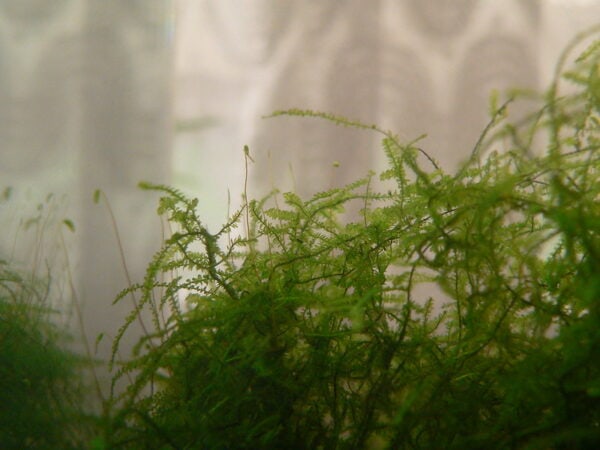
The rhizoids are a great feature of the Java Moss because of their adaptability. You can place the java moss anywhere in the aquarium, and they’ll take to the decorations and flourish with minimal trouble.
For years, confusion has prevailed about the apparent scientific name of the Java Moss. If you research a little more about it, you will find that initially, Java Moss was known as Vesicularia dubyana. However, it was only recently that it got classified with the name Taxiphyllum Barbieri.
You can find many researchers debating the accuracy of this change.
To this day, scientists still aren’t sure what to call the Java Moss. It was formerly believed to be vesicularia dubyana and was sold in fish stores under this name. However, because there is no proof that the Java Moss in the aquarium trade is the same species as what we find in the wild, they have now been under a different name – taxiphyllum barbieri. Although we’re pretty sure some aquarium shops still sell them under vesicularia dubyana.
This perplexing plant has caused many debates in the scientific community, and its problem continues to confound us. If you ask for the vesicularia dubyana in an aquarium store, you will end up with Christmas moss or Singapore moss rather than the common java moss.
| Information Chart | Java Moss |
|---|---|
| Scientific name | Taxiphyllum Barbieri |
| Family | Hypnaceae |
| Care Level: | Easy |
| Average Size: | 3-10 inches |
| Family: | Hypnaceae |
| Minimum Tank Size: | 5 gallons |
| Temperature: | 59-86 °F (15-30 °C) |
| Water Conditions: | pH 5-8 |
| Placement: | Front to middle or carpeting |
- LIVE AQUATIC PLANTS : JAVA MOSS from Greenpro come with a portion cup. Growing beautifully, spreading dense...
- EASY AND READY TO GROW : Moss can be grown in any size of tank. Nano tank, shrimp tank, betta etc to large...
Java Moss Appearance
As discussed above, Java moss is a green-colored aquatic plant. It has a stem of about 2mm. Java Moss has long oval-shaped leaves. Its leaves are smaller as compared to other aquatic plants.
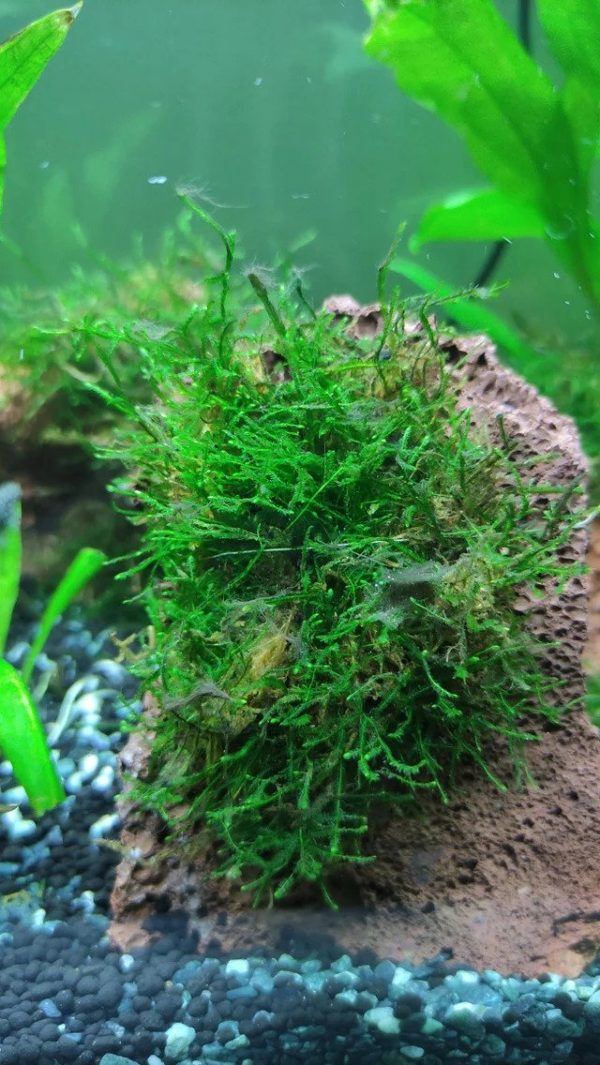
However, the Java Moss that grows under-water will have leaves brighter and bigger than those that grow on the land. Many aquarists prefer to carpet the tanks and aquariums with Java Moss.
When you first introduce the java moss to your aquarium, it will be a bright green color indicating that it’s a young and healthy plant. As the java moss ages, the green hue will darken to become a deeper green shade. Java moss can grow to be both underwater and above. If these aquatic plants do manage to make it out of your tank, you will find that the leaves grown above water tend to be larger in size.
Java Moss: Size
Now, if you wish to get Java Moss to enhance the look of your tank, you might be interested in knowing about its size. The height of Java Moss ranges between 2 inches to 4 inches. It is approximately 5-10 cm in height.
If you keep the Java Moss in low light and unpruned conditions, there is a chance that they might grow taller. However, you should note that growing the Java Moss in low light might make it less dense. Therefore, it is up to you how you want the Java Moss to grow in your fish tank or aquarium. If you want it to become taller and less dense, you should keep it in the low light.
Java Moss: Care And Tank Setup
Java Moss care is straightforward, requiring minimal maintenance. Ideal for aquascaping, it thrives in a range of water conditions and lighting levels. The plant attaches to surfaces in the tank, like rocks or wood, enhancing the aesthetic appeal. It provides shelter for fish and fry, contributing to a healthy aquarium ecosystem. No substrate is needed for its growth, making it a versatile choice for various tank setups.
If you want to bring Java Moss to your fish tank or aquarium, you should be aware of its maintenance. The tank requirements are also a big concern when setting up Java Moss in the tank or aquarium.
Let us discuss the tank requirements for installing the Java Moss plant.
Java Moss: Tank Size And Specifications
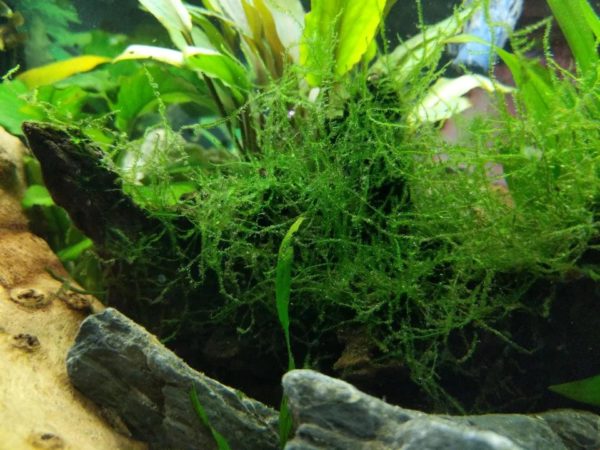
If you want the Java Moss to grow in the tank, you must ensure a good water current. The water in the tank should be slightly acidic, and the temperature of the tank should range between 21-24 degrees Celcius.
Java Moss: Optimum Tank Size
Installing Java Moss in your tank is not a big issue. You can sustain the plant in your tank without any hassle. However, your tank’s capacity should be a minimum of 5 gallons if you want the Java Moss to grow beautifully.
Java Moss: Tank Shape
You don’t have to worry about the tank shape when growing the Java Moss. You can grow them in a tank of any shape as long as it has fresh water.
Filter Type
Well, if you plan to adorn your tank with Java Moss, here is good news for you. Java Moss does not require any filtration, and it can grow even in poor water conditions.
Substrate
You don’t have to think about substrate when planting the Java in the tank. It does not need any substrate as it attaches itself to the surfaces. It can also act as a floating plant. It uses the substrates of sand and dirt in the aquarium, so you don’t have to worry about any additional substrates.
How Many Java Moss In 5 Gallon Tanks?
You can buy a few clumps of Java Moss for a 5-gallon tank. The Java Moss will multiply with time and spread throughout the tank. You can buy more clumps of Java Moss if you have a bigger tank.
Water Parameters For Java Moss
Water Temperature
As discussed before, the tank’s temperature should range between 21-24 degrees Celcius.
If maintaining this temperature seems like a challenge, you don’t have to worry because it can tolerate a temperature up to 30 degrees Celcius. However, there is one thing that you should know about this temperature. Warm water will alter the growth of the Java Moss in the tank.
So, if you keep the temperature of your tank at 30 degrees, it will have a staggering growth rate. To get the Java Moss to grow faster, you can keep the tank’s temperature at about 24 degrees. This temperature will promote the healthy and beautiful growth of the plant.
pH Level
The perfect pH level for the Java Moss is 5.0-8.0. To maintain a healthy growing environment for Java Moss, you should ensure that the pH level is per the prescription.
Water Hardness
The water hardness is also an issue when trying to maintain the tank’s health and the growth of the Java Moss. Java Moss will survive better with a water hardness of up to 25°dGH. You should also maintain a carbonate hardness of 20°dKH to grow Java Moss in the tank.
Java Moss Tank Landscape
Java Moss can act as a great carpet in your freshwater tank. We know that the fishes require carpets in the tanks. These carpets provide them security and protection, and Java Moss is an excellent plant for the job.

Java Moss can grow into a thick and dense carpet in your fish tank. Java Moss will also protect the shrimp, crabs, and snails in your tank.
You can plant the Java Moss alongside the tank wall as well. Before doing so, you should ensure that it has adequate space to grow and expand. You can plant Java Moss in your tank using several methods mentioned below.
Super Glue Method
You need to install Java Moss in an anchor deck, super glue gel, a clean spray bottle, and forceps. You can glue the Java moss in the tank using these materials.
Tying Method
You will need anchor decks in the form of rocks, drifts, etc., a fishing line, a cotton thread, a clean spray bottle, and scissors. Using this method, you can tie the Java Moss in the tank. However, the ties can break with time. But, by the time that happens, the Java Moss will have struck to the surface.
Carpeting/Walls
To carpet your tank with Java Moss, you need the following things.
- Java moss
- 2 Sheets (at least) of plastic canvas
- Suction cups
- Scissors
- Fishing line
- Plastic canvas needle
- Measuring tape
- Small knife
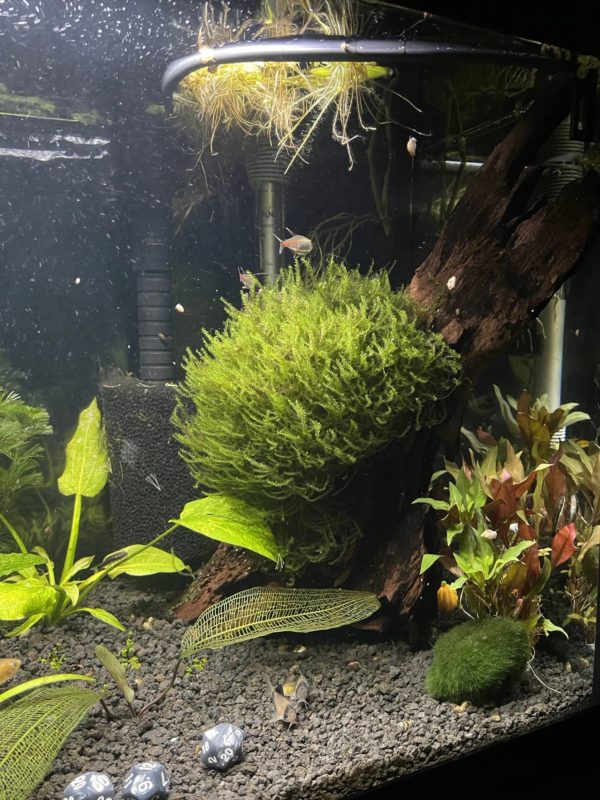
You can install the Java Moss plant into the tank or aquarium without any difficulty using these things. Before doing so, make sure you measure the carpet area of your tank.
Lighting for Java Moss Plant Tanks
You can choose any lighting to grow Java Moss. The lighting can either be low or high. As mentioned before, there will be a difference in the growth of the Java Moss depending on the light.
The growth of Java Moss in low light will develop a dark and lankier plant. On the other hand, high lighting will make your Java Moss grow into a dense and compact plant.
However, there is only one problem with the high lighting. The high lighting paves the way for the growth of more algae in your tank.
Nutrient Requirements For Java Moss Plants
If you want to speed up the process of its growth, you can add more CO2 and fertilizers to the tank. However, it is not necessary to do so because Java Moss will grow perfectly without any fertilizers. Also, you need not stress about its compatibility with the fish in your tank. It is compatible with all fish species.
Java Moss: Compatibility And Tank Mates
Java Moss compatibility and tank mates are an issue while making it a part of your tank. The Java Moss is harmonious with all the species of fish. It stays in harmony even with the shrimps.
However, if you have Goldfish in your tank, you might want to watch your plant. Goldfish are known to snack on the Java Moss, so you should be extra cautious.
Java Moss Uses
The java moss is a multifunctional and diverse plant to have in your aquarium. Other than the fact that they can create an underwater forest, it also makes a great breeding tank plant. Many fish species like to lay eggs on flat surfaces or on plants and the java moss is a highly coveted choice. After hatching, the java moss makes a great place for the fry to play hide and seek and it can even act as territorial barriers when setting up your tank for more aggressive species.
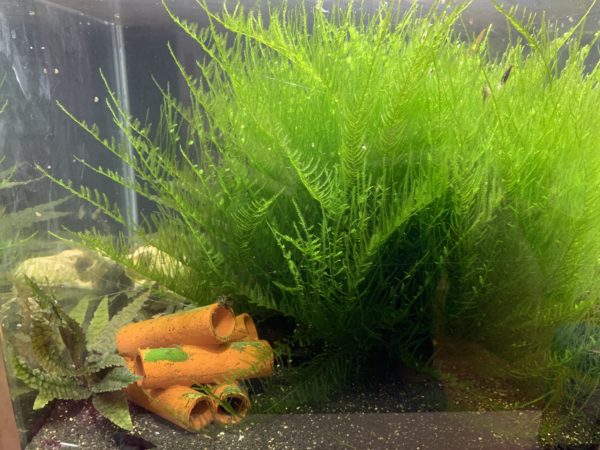
The moss can also be a source of food and nutrients for new-born fry. Small organisms known as infusioria, which is consumed by baby fish. Ornamental shrimp are also big fans of these moss plants. They see them as their own personal buffets as they sift through the growth to find deposits of algae and other scraps of plant debris for food.
For aquascaping, you can choose to carpet the tank with java moss, which will create a lush grassland at the bottom of your tank. After maturing, the java moss will literally look like a green carpet. If you want to line the walls of your tank that is possible as well if you attach the java moss to the sides instead of the bottom.
To create a miniature underwater forest, you would need java moss trees for added effect. To do this, find pieces of driftwood that resemble tree trunks with branches and have the java moss attach itself. As time goes by, the java moss will encircle the driftwood and become very tree-like.
Java Moss Tank Requirements
As said, the java moss is considered a hardier species of aquarium plants. We classify a plant as hardy and robust if they can take to water changes well and adapt to different environments. Although they can survive in different water conditions, it’s best to simulate their natural environment and keep temperatures at 21-24 degrees Celsius. Although they are considered a tropical moss plant, they thrive in slightly cooler temperatures.
In cooler water temperatures you will also notice a faster growth rate and a healthier-looking plant. As for water flow, the java moss prefers moderate currents with slightly more acidic water quality. One of the best things about java moss is it can take to any environment as long as it’s somewhat similar to that of Southeast Asia. Both high and low light are acceptable for the taxiphyllum barbieri, though you will notice a difference in aesthetics.
Java moss that grow in high lighting will display dense leaves and brighter color whereas a java plant that grows in darker lighting will emulate these conditions with darker coloring and sparse growth.
Adding CO2 isn’t a must but it sure does help with faster growth. If you are impatient for a lush green tank, CO2 and fertilization among other things can help. Speaking of fertilization, liquid form is the best since the java moss absorbs nutrients through its leaves.
Java Moss Care
Adding java moss to your tank is as easy as 1,2,3. All you need to do is place the plant near something it can latch on to and leave it alone. However, there are certain steps you can take to help ease the transition. It helps to bleach and dechlorinate the plants before introducing them to the tank.
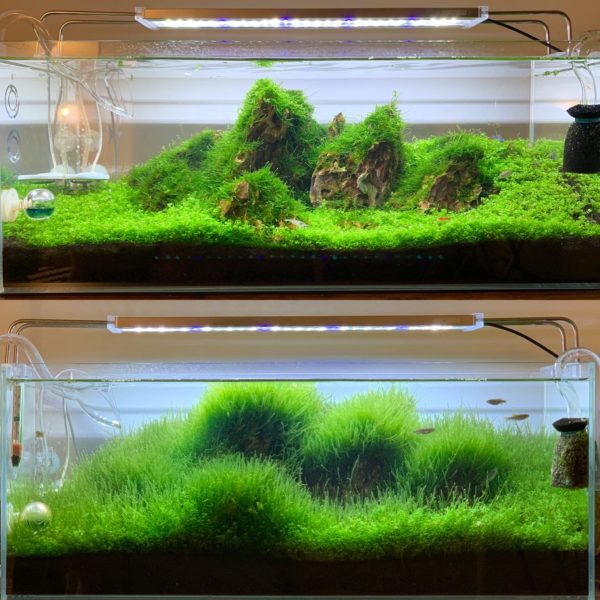
How long does java moss take to attach? About 3-4 weeks. Once it’s fully attached and secure inside your tank, the java moss plant can pretty much be left alone for the remainder of the time with casual pruning sessions here and there. It is similar to hedges wherein you can choose to let it grow and flourish or trim different shapes. All you need is a pair of scissors to work your magic.
Issues with Java Moss
If you decide to line the walls of your aquarium with java moss, there is a good chance it could clog your filter if you have one. Another minor issue is if you let your java moss run wild, it could grow so thick that there is barely room for other plants and fish in the tank. For this reason, it’s still highly recommended to give it a good trim every now and then.
Now onto the more pressing issues. One mortal enemy the java moss faces is algae. Algae flourishes in poor water quality and strong lighting conditions. Once the algae intertwine itself into the java moss, they can be extremely stubborn to remove. Your best bet would be to remove all the contaminated java moss and start from scratch. If you have a planted aquarium, one way to save your tank is to add cleaner creatures such as shrimp to get in there and do the job.
Surprisingly, hydrogen peroxide is a substance that can be used to treat algae in java moss. It will kill the algae but leave the java moss unharmed. You can try this by draining the tank about 25-50%, inject the peroxide into the remaining water and let it soak. After a few minutes, you can refill the tank and hopefully, your problem will be solved. Going in manually with a soft-bristled toothbrush is another way to remove the algae in small amounts.
Remember that a little bit of algae is okay, but having them grow in abundance can be detrimental to your tank and the balance of the isolated ecosystem.
One other common issue that isn’t detrimental to their health is trimming the java plant. Since they can grow to be pretty dense, trimming can be a mess. If you leave your moss plant for too long, the trimmings can overtake the aquarium and even get stuck in your filters. Depending on your fish, having the plant debris floating around may not be the best for water conditions and can create a mess in your aquarium.
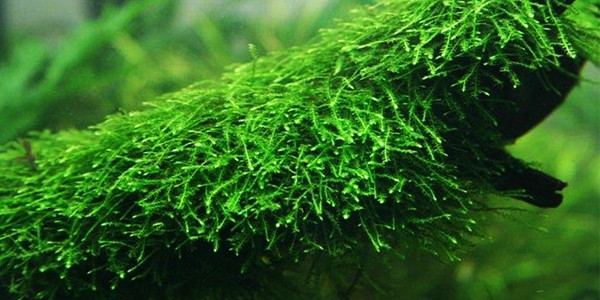
How to Grow and Plant Java Moss
How do you grow java moss? Let’s take a look at how. Java moss is not recommended to be left floating (although you can), so to add them to your tank you will need plenty of decorations. Look into rocks, driftwood, and plastic mesh for anchoring. Since attaching can take a long while (3-4 weeks), there are some steps you can take to speed up the process.
First up is the superglue method. It may seem counterintuitive to use something artificial for natural growth, but it works. Take the decoration you wish to secure the moss onto and dab a bit of superglue on the surface. Take the java moss and press it gently into the superglue and count to 5 seconds. Once it seems secure, you can place the decoration with the moss attached back into the tank.
If you aren’t so sure about superglue, we have another method that involves a fishing line. This is referred to as the tying method. It’s essentially the same as using superglue, your goal is to fasten the plant securely to the decoration with the fishing line. Once you have tied it tightly around the object, trim the excess fishing line and place the moss plant and rock back into the tank.
How do you line your tank with java moss? If you want to carpet or line your tank, then the steps are a bit different. First off, prepare sheets of plastic canvas and decide where you want the java moss to grow, then clean that part of the tank very well and make sure there is nothing between the moss and the tank glass.
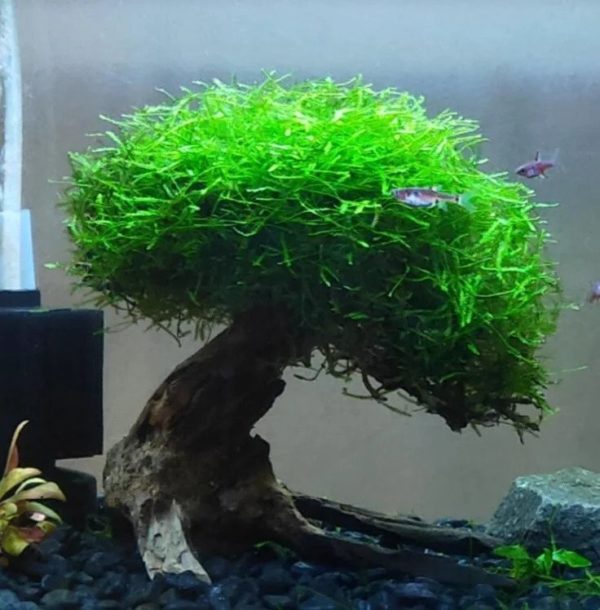
Cut the 2 plastic sheets down to the right size. Puncture the plastic sheets with the tip of an exacto-knife for you to attach suction cups through. Place a thin layer of java moss onto the sheet with suction cups and the other one with exact dimensions over it to sandwich the moss.
Fasten the two plastic sheets together with string and secure the sheet with suction cups to the side of the tank. For carpeting, the same steps are taken except the sheet is placed on the bottom of the tank.
Java moss trees, as we mentioned, can be created by allowing the java moss to intertwine itself with driftwood or other decorations in unique shapes. You would attach the moss to the object and place it in the tank. After a few weeks, you will notice the moss plant starts to wrap itself around the item.
Java moss propagation is as easy as the java fern. All you need to do is cut off a piece (about 2 inches long) from the thriving moss plant and attach it the same way you did with the mother plant to other decorations. That’s all it takes to create more java moss.
Does java moss grow fast? In general, the java moss isn’t a fast-growing plant, although more light and suitable water conditions will speed up the process. To make sure you have a healthy and hardy java moss plant, you need to take good care of it and regularly check the algae levels.
Java Moss Maintenance
Once you successfully grow java moss, you can pretty much just leave it alone. However, below are a few tips to help maintain your moss plants to make sure they are always in tip-top shape.
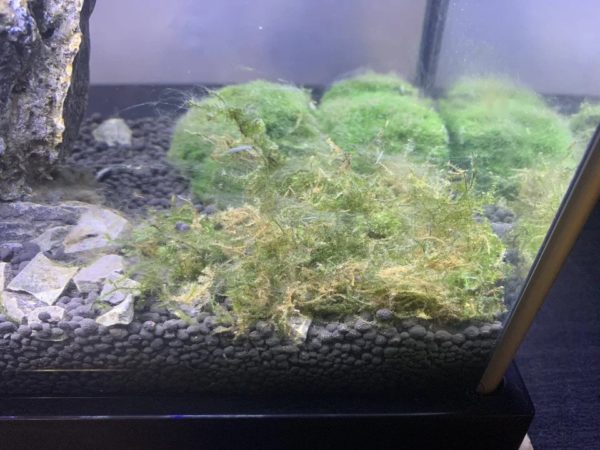
Java moss is a dense plant. As you can probably imagine, a plant with dense growth will trap debris and waste between its leaves, which can get pretty gross after a while. For this reason, cleaning may be required for the moss plants. Since your moss plants will most likely be attached to a decoration or plastic mesh, the easiest way to deal with trapped gunk is to remove the plant from the aquarium and give it a thorough rinse.
A dense plant can grow into a tangled mess. The moss can survive regardless of how it looks but the maintenance can be quite a headache if left untended. A good way around this is to trim it regularly. This will also solve the issue of having algae trapped in the leaves and making a big mess during trimming sessions.
Facts About Java Moss
- Java Moss is scientifically known as Taxiphyllum Barbieri.
- It is easy to care for and grow Java Moss.
- You can grow Java Moss in either low lighting or high lighting.
- The ideal temperature to grow Java Moss ranges between 15 degrees Celcius to 30 degrees Celcius. However, the perfect temperature to grow Java Moss is 21-24 degrees Celcius.
- You don’t need fertilizers or any extra nutritional substance for the Java Moss to grow.
- Java Moss can grow without any additional CO2 requirements.
- You don’t have to worry about Java Moss’s maintenance as it can maintain itself without much effort.
- Java Moss sticks to the surface of the tank and grows gradually.
- Java Moss that grows underneath the water has more bright leaves than the Java Moss on the surface.
- Java Moss can be messy to trim.
- The plant can get fouled up with dirt over time.
- The growth of Java Moss is slower than other aquatic plants. However, if you don’t maintain it properly, the Java Moss can get out of hand.
Is Java Moss Right For You?
There are a few reasons why Java Tank could be a perfect fit for your tank.
Java Moss can handle the shifting water conditions very well. You don’t have to be concerned when the water levels temporarily get thrown off the base. Another thing that Java Moss can handle perfectly is tank cycling. Therefore, it is one plant that you should add to your tank.
You can easily find Java Moss at any store around your house. You can even place an order for Java Moss online. Therefore, you shall have no difficulty in getting this plant.
There might be some fish in your tank that like to stay at the bottom. It is a perfect shelter for those fishes as it provides a dense mat. The fishes that prefer to grow in low light can benefit from this plant as it does not have any trouble growing in low light.
Interestingly, Java Moss can serve as a spawning place. If you plant Java Moss in your tank, it can serve as a good shelter for the eggs and hatchlings. Some microbial colonies form the leaves of the Java Moss. These microbial colonies act as the first food source for the larvae after losing their yolk sacks.
Apart from this, Java Moss acts as a great decorative item for your tank. If you clean this plant regularly and keep it well, it will make your tank or aquarium look beautiful.
FAQs
At what speed does Java Moss grow?
The speed at which the Java Moss grows will depend upon the plant’s environment. It grows the best when kept at about 21-24 degrees Celcius. If you want your plant to grow fast, you can keep it in high lighting and ideal temperature.
It grows equally well in low lighting. However, it might not become very dense when you keep Java Moss in low lighting.
Is it expensive to purchase Java Moss?
It might seem that the price you have to pay to bring Java Moss home is too much. However, the plant will add beauty to the tank by turning into a big carpet over time. Java Moss grows quickly so that it can be a beneficial investment.
Is it complicated to grow Java Moss?
You don’t have to sweat about growing and maintaining Java Moss. Of Course, Java Moss requires some maintenance, but it is not something about which you should worry. It is very simple to grow Java Moss.
What should I do to make the Java Moss grow faster?
If you want the Java Moss in your tank to grow fast, consider putting it in a brighter light. However, while doing so, you should be careful that exposing the Java Moss to more light can accelerate the growth of algae in your tank.
Conclusion
Is the java moss a good addition to your aquarium? Due to the hardy and low maintenance nature of the plant, the answer is most likely yes! It’s a moss plant that is suitable for most aquariums as it grows easily with minimal effort. Most fish will take to the moss, which also makes it a great choice for breeding tanks. The dense leaves make it a great surface for spawning and they can double as great hiding places for newly-hatched fry.
Java Moss is a beautiful plant that can add elegance to your tank. You don’t have to devote much time to its maintenance and growth. It does not require additional nutrients or fertilizers to speed up the growth process. It is an excellent option for aqua-scaping your tank as it can build carpets and walls. Your fishes and shrimps will love these plants as they serve as a shelter for their protection.
For territorial or aggressive fish, the java moss can act as a barrier or territorial lines to minimize predatory behavior. Whether you have an aquarium full of fish or just one with plants, the moss plant is great for beginner aquarists. They are also very affordable and are easy to propagate. As long as water conditions are optimal, java moss grows quite easily in any lighting.
One problem to keep in mind with the moss plant is its natural aversion to algae. It is a photosynthetic creature that grows in tanks and can get lodged in the overgrown leaves of the moss. Adding cleaner fish and crustaceans to the water can help minimize buildup. All in all, the java moss is a plant that goes with almost any species of fish and can really be quite beautiful in your underwater ecosystem.
No related posts.

